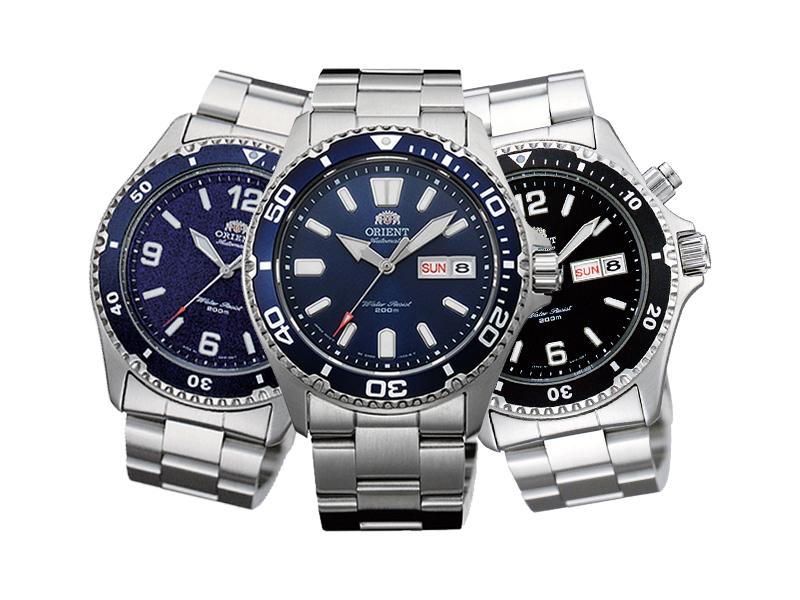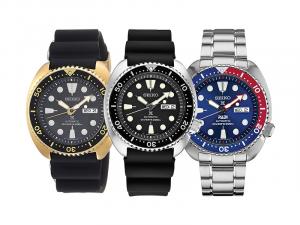Orient Mako: Everything You Need to Know About the Affordable Diver

Surely, you’ve heard of Orient. The brand — often deemed as one of the most affordable automatic watches — offers timepieces that are worth every penny. Safe to say that Orient is every collector’s entry-level automatic. The brand offers a bunch of choices that overall almost never disappoints. You will always end up with a trusty mechanical watch without spending a fortune. And one of the most celebrated Orient watches should be the Mako. Every collector, old or new, recognises the Orient Mako as an affordable choice for a diving watch.
But if you take a quick dive into Google, you might be lost in the sea of results. So, we gathered all the information you need about the Mako. What’s Orient Mako USA and why does it look different? Is the Orient Mako II worth it? Is there an Orient Mako 3? How do you differentiate a Mako from other Orient watches?
Brief History of Orient Watches
Orient, a subsidiary of Seiko Epson easily became a favourite since its launch in 1950. However, the journey before its foundation was quite a bumpy ride for its founder, Shogoro Yoshida. In 1901, Yoshida opened a humble wholesale shop in Ueno, Taito, Tokyo, Japan. Needless to say, the shop met its success by selling imported pocket watches to the Japanese market. This is why it’s no surprise that he expanded his business later in 1912. At the time, he also began producing gold wristwatch cases. Yoshida ran a generally successful business that ultimately won the heart of many enthusiasts in Japan.
The Aftermath of War
In 1920, Yoshida established Toyo Tokei Manufacturing. The company produced table clocks and gauges. However, the company sought a greater market by producing wristwatches in 1934. Two years later, the company opened a factory in Hino, Tokyo, Japan. This ultimately proved to be a wise investment as the business boomed upon its opening. However, due to the Second World War, the economy of the country plummeted. This forced the company to shut down in 1949.
But Yoshida pushed forward to revive his business and in 1950, he established Tama Keiki Company. It continued what Toyo Tokei Manufacturing couldn’t finish. Yoshida utilised the same Hino factory in producing watches. A year later, Tama Keiko Co. changed its name to Orient Watch Company, Ltd. In the same year, the company launched the Orient Star. This very watch became known even overseas. The Orient Star stood out for its small case size and timeless design. This only began the many feats Orient achieved such as the Royal Orient, Grand Prix 100, and Fineness. At the time, the Fineness was the world’s thinnest automatic wristwatch with a day-date calendar function.

The Orient Mako
First released in 2004, Mako was Orient’s flagship model. Upon its release, the Mako became an instant hit as an affordable diver. It has just the right dive watch features that make your purchase worth it. Many newcomers to mechanical watches buy the Mako as their entry-level watch. It’s due to its affordable price point compared to other dive watches in the market at the time of its release.
After a decade of its release, Orient itself reached out to a community of enthusiasts for feedback about the Mako. Their inquest flocked them with a bunch of upgrade suggestions such as a sapphire crystal and a reworked bezel. Orient took these suggestions and applied them to the Mako USA and the subsequent Mako USA II.
The Nickname ‘Mako’
Mako is not a term you can search for on Orient’s website. It is a nickname given by enthusiasts to the watch with its release. But there are various versions of the story and none of it was ever confirmed. But the most popular version would be due to the dolphin on the original rubber strap of the watch.
When Mako was released, patrons had the option to opt for a metal bracelet or a rubber strap. The rubber strap had an image of a dolphin. However, an enthusiast decided it look a lot more like a shark than it was a dolphin, thus the nickname “Mako” after the shortfin mako shark. Somehow, the name stuck that even Orient called the watch Mako. Orient even spearheaded a contest for the name of the CEM7500 series, a larger version of the original Mako. Mako XL ultimately won.

How to Differentiate Mako Watches
There are two faces to know if you’re searching for a Mako in a sea of Orient watches. There would also be variations of a single model mainly the regular version and the USA version. So, you’ll probably see a Mako and a Mako USA, as well as a Mako II and a Mako USA II. So what sets these versions apart from each other and from other Orient watches?
1. Look
The regular Mako and Mako USA both have a 41.5 mm diameter case. But Mako has two faces: one for a regular and another for the USA version. The regular Mako has an Arabic index for the 12, 6, and 9 o’clock markers. It also has a mineral crystal that’s flat with a little bit of rising. It gives the Mako even more depth but could be vulnerable to scratches.
The Orient Mako USA, on the other hand, does not have Arabic numbers as indexes. It only has large lume-filled index hour-markers. This change makes the time more legible compared to the regular version. The USA version also has a sapphire crystal that has better scratch resistance than the regular model’s mineral crystal. The drilled lugs are also noticeable as they are missing from the original Mako. While a lot of people liked the old spring-less bar hole in the lugs, a lot of people still requested the change. Additionally, Mako USA has solid-end links, making it more secure and tight around the wrist.
2. Function
One of the notable differences of the Orient Mako USA from the regular Mako would be the bezel. This is due to the response of the crowd on the regular Mako’s 60-clock rotating bezel. With the release of the Mako USA, the bezel is also improved with a 120-click bezel. It also has a more solid and secured turn with an even slighter wobble versus the old original bezel. Both watches, however, offer 200 metres or 660 feet of water-resistance.

3. Movement
The first Mako USA had the same movement as the original Mako. Both had Orient’s in-house, made-in-Japan automatic mechanical Calibre 46943. The movement offered time with a day-date feature but not a hand-winding feature. The only means of winding the watch would be through wearing the watch, putting it on a winder, or by turning the rotor manually. Not to mention, it also has 40 hours of power reserve.
Meanwhile, the Mako II and the Mako USA II has the Orient F6922 calibre. Compared to the Calibre 46943, there wouldn’t be much of a difference when it comes to the power reserve, as well as the vibrations. It still has 40 hours of power reserve and functions at 21,600 beats per hour. However, the improvement reveals itself in the accuracy of the movements. The Calibre 46943 has an accuracy of -25/+35 sec. On the other hand, the Calibre F6922 has an accuracy of -15/+15 sec. Orient also added hacking and manual winding functions to the Calibre F6922.

The Orient Mako XL
So far, we’ve tackled four Mako watches under the collection. Those alone can be confusing but don’t fret. Once you remember the differences between the original Mako and the Mako USA, you’ll surely easily spot one from the other even from afar. But the Mako collection end with just four models. They also have a much larger version as I mentioned earlier. The name came from a contest that Orient themselves initiated. Appropriately so, the watch was named Mako XL.
Orient launched the Mako XL just before the Mako II. It’s mostly a response to a community of collectors and enthusiasts to have a larger version of the Mako watch. However, the community expressed great disappointment with the XL with the lack of Arabic numerals, different arrow hands, and more.
The watch is 3mm wider than the Mako I with a barely different blueprint than its predecessor. With a 44.5mm diameter, the Mako XL is thicker at 13.3mm. And because it’s almost the same as the Mako I (only bigger), it has the Calibre 46943 automatic movement. It’s non-hacking, non-winding, and also has a pusher button at 2 o’clock for day changes.

The Yellow Mako
Ten years since Mako’s first release, Orient re-released the limited-edition Yellow Mako. Mako watches usually come in colours such as black, blue, and orange. There’s also a version of the blue dial with a bezel splashed with a shock of red. That is why the Yellow Mako was such a hit when it was released as a limited-edition watch in the US. It sold out so quickly and only in 2014 did Orient decide to revive the rare watch, still a US-only release. Reference FEM65001YW only had 90 pieces made. Aside from its striking yellow dial, there’s no other difference between the Yellow Mako and the other Mako watches.
Does the Mako III Exist?
The Mako collection can’t get any more confusing than this.
This is still an argument but a lot of people say that the Mako III does, indeed, exist. However, it can’t be found on the Orient Watch USA website. It is also not as popular as its predecessor especially that it often gets compared to the Orient Kamasu.
According to some enthusiasts, the Orient reference RA-AA0008B is the Mako III. It’s patterned after the Mako USA II with a non-numeric index, as well as the use of Calibre F6922. Because of such a close similarity with the Mako II and the Kamasu, a lot of people disregard the existence of the Mako III.
Differences Between the Orient Mako II and III
The Mako III can be a closer relative of the Mako USA II than the original Mako II. It’s due to the indexes. However, if you put these watches side by side, the difference remains noticeable. Firstly, the bezel now has a coin-edge pattern versus the sub-edge. It also lacks individual minute marks. Secondly, the second hand of the Mako III doesn’t have red edges which could be a disadvantage, especially for legibility. The unframed day-date of the Mako III can be compared to that of the Mako XL’s. Moreover, the Mako II’s “Water Resist 200m” script changed to for a “Water Resist 20 Bar”.

Differences Between the Orient Mako III and the Orient Kamasu
Right off the bat, there’s already a huge difference with the way the Mako III and Kamasu look. The Orient Mako III is a bit bigger at 43.6 mm while the Kamasu is around 41.8 mm in diameter. The Mako III’s coin-edge bezel also begs for a strong difference against Kamasu’s sub-bezel.
On the dial, you’ll notice the difference on their 12 o’clock markers as well as their hands. The Kamasu has an arrow hour hand while the Mako III has a sword hour hand. Kamasu, however, has a sapphire crystal which makes it more expensive than the Mako III that has a mineral crystal.
Aside from these specs, everything else about the two would be incomparable. So, make sure you check the watch you’re buying before deciding it’s a Mako III.
Final Thoughts
The Orient Mako collection is a whole lot to unpack — quite literally. However, it’s one quality dive watch that will surely win you at first glance. For such an affordable watch, it has all the basic functions of a dive watch. Moreover, its automatic movement makes for such a compelling case. Once you understand the difference between the Mako watches, there’s really nothing else to be confused about. The Mako collection should be the realisation of the phrase “the devil is in the detail”.
If you ask any collector, they definitely have the Mako in their collection. This could be the reason why the Mako has so many versions: collectibility. After all, each of these watches serves more than just function. It may not be Orient’s only dive watch, but it’s surely something worth checking out.
Looking for more affordable dress watches? Check out our review of the Orient Bambino!


